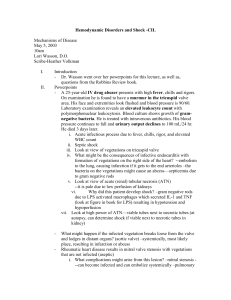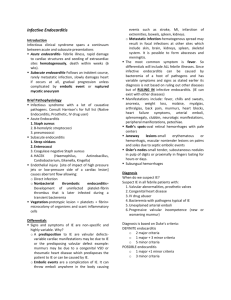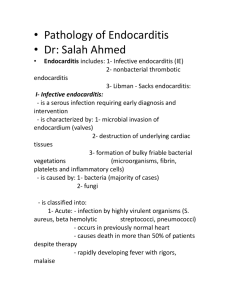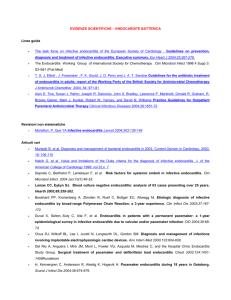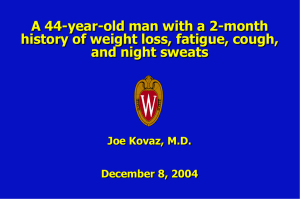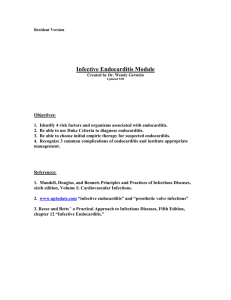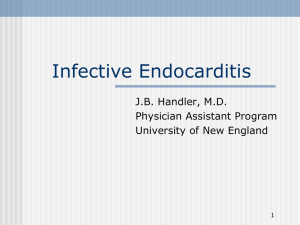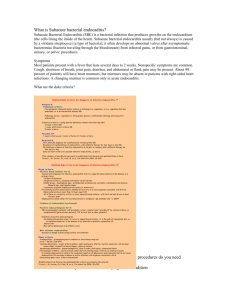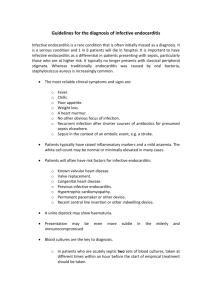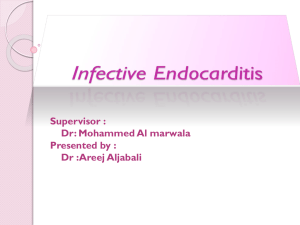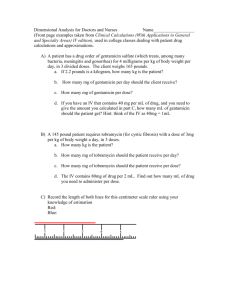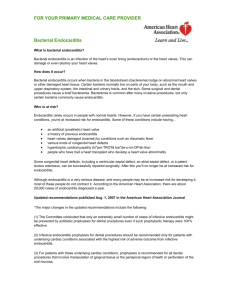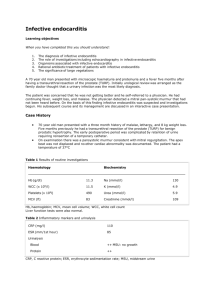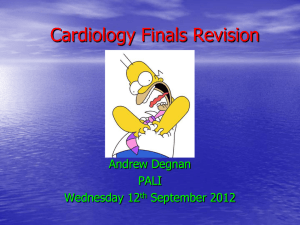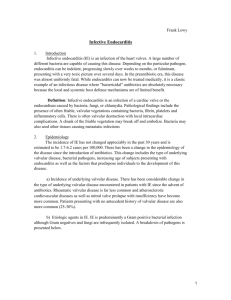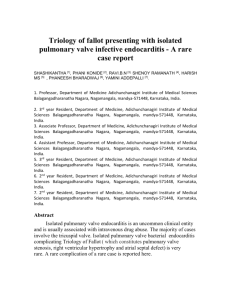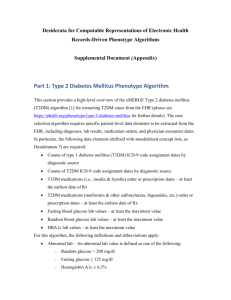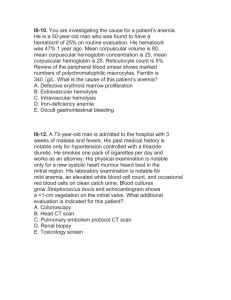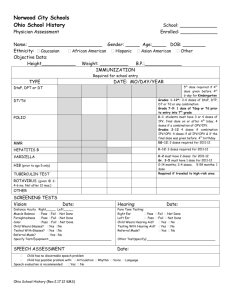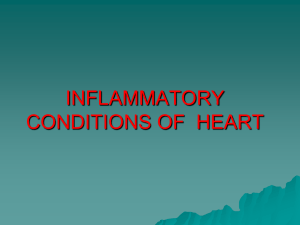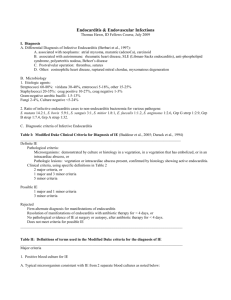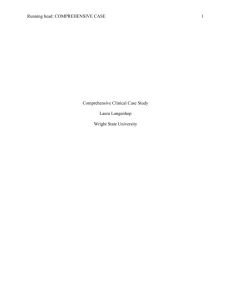Infective Endocarditis
advertisement
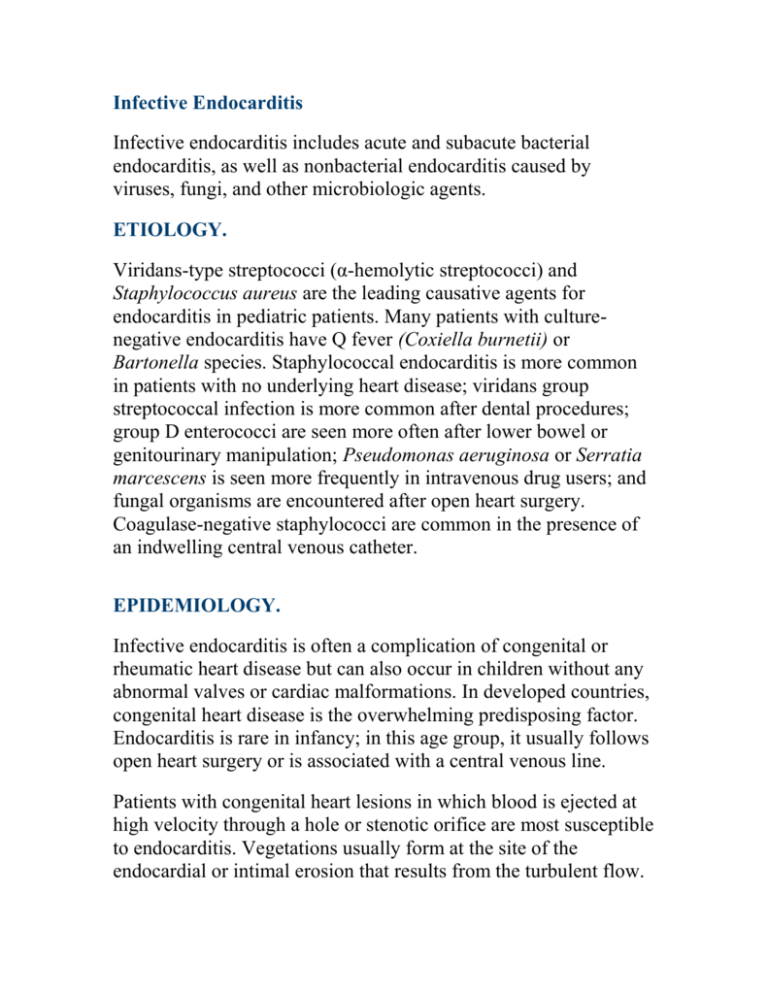
Infective Endocarditis Infective endocarditis includes acute and subacute bacterial endocarditis, as well as nonbacterial endocarditis caused by viruses, fungi, and other microbiologic agents. ETIOLOGY. Viridans-type streptococci (α-hemolytic streptococci) and Staphylococcus aureus are the leading causative agents for endocarditis in pediatric patients. Many patients with culturenegative endocarditis have Q fever (Coxiella burnetii) or Bartonella species. Staphylococcal endocarditis is more common in patients with no underlying heart disease; viridans group streptococcal infection is more common after dental procedures; group D enterococci are seen more often after lower bowel or genitourinary manipulation; Pseudomonas aeruginosa or Serratia marcescens is seen more frequently in intravenous drug users; and fungal organisms are encountered after open heart surgery. Coagulase-negative staphylococci are common in the presence of an indwelling central venous catheter. EPIDEMIOLOGY. Infective endocarditis is often a complication of congenital or rheumatic heart disease but can also occur in children without any abnormal valves or cardiac malformations. In developed countries, congenital heart disease is the overwhelming predisposing factor. Endocarditis is rare in infancy; in this age group, it usually follows open heart surgery or is associated with a central venous line. Patients with congenital heart lesions in which blood is ejected at high velocity through a hole or stenotic orifice are most susceptible to endocarditis. Vegetations usually form at the site of the endocardial or intimal erosion that results from the turbulent flow. Children with ventricular septal defects (VSDs), left-sided valvular disease such as aortic stenosis, tetralogy of Fallot, and systemicpulmonary arterial communications (patent ductus arteriosus or Blalock-Taussig shunts) are at highest risk. In older patients, congenital bicuspid aortic valves and mitral valve prolapse with regurgitation pose additional risks for endocarditis. Surgical correction of congenital heart disease may reduce but does not eliminate the risk of endocarditis, with the exception of repair of a simple atrial septal defect or patent ductus arteriosus. Children who have undergone valve replacement or valved conduit repair are also at high risk Manifestations of Infective Endocarditis HISTORY Prior congenital or rheumatic heart disease Preceding dental, urinary tract, or intestinal procedure Intravenous drug use Central venous catheter Prosthetic heart valve SYMPTOMS Fever Chills Chest and abdominal pain Arthralgia, myalgia Dyspnea Malaise Night sweats Weight loss CNS manifestations (stroke, seizures, headache) SIGNS Elevated temperature Tachycardia Embolic phenomena (Roth spots, petechiae, splinter nail bed hemorrhages, Osler nodes, CNS or ocular lesions) Janeway lesions New or changing murmur Splenomegaly Arthritis Heart failure Arrhythmias Metastatic infection (arthritis, meningitis, mycotic arterial aneurysm, pericarditis, abscesses, septic pulmonary emboli) Clubbing LABORATORY Positive blood culture Elevated erythrocyte sedimentation rate; may be low with heart or renal failure Elevated C-reactive protein Anemia Leukocytosis Immune complexes Hypergammaglobulinemia Hypocomplementemia Cryoglobulinemia Rheumatoid factor Hematuria Renal failure: azotemia, high creatinine (glomerulonephritis) Chest radiograph: bilateral infiltrates, nodules, pleural effusions Echocardiographic evidence of valve vegetations, prosthetic valve dysfunction or leak, myocardial abscess, new-onset valve insufficiency DIAGNOSIS. The critical information for appropriate treatment of infective endocarditis is obtained from blood cultures. All other laboratory data are secondary in importance. Blood specimens for culture should be obtained as promptly as possible, even if the child feels well and has no other physical findings. The Duke criteria help in the diagnosis of endocarditis. Major criteria include (1) positive blood cultures (two separate cultures for a usual pathogen, two or more for less typical pathogens) and (2) evidence of endocarditis on echocardiography (intracardiac mass on a valve or other site, regurgitant flow near a prosthesis, abscess, partial dehiscence of prosthetic valves, or new valve regurgitant flow). Minor criteria include predisposing conditions, fever, embolic-vascular signs, immune complex phenomena (glomerulonephritis, arthritis, rheumatoid factor, Osler nodes, Roth spots), a single positive blood culture or serologic evidence of infection, and echocardiographic signs not meeting the major criteria. Two major criteria, one major and three minor, or five minor criteria suggest definite endocarditis. A modification of the Duke criteria may increase sensitivity while maintaining specificity. The following minor criteria are added to those already listed: the presence of newly diagnosed clubbing, splenomegaly, splinter hemorrhages, and petechiae; a high erythrocyte sedimentation rate; a high C-reactive protein level; and the presence of central nonfeeding lines, peripheral lines, and microscopic hematuria. PREVENTION. Recommendations of the American Heart Association for Prophylaxis Against Bacterial Endocarditis DENTAL AND ORAL PROCEDURES OR SURGERY OF THE UPPER RESPIRATORY TRACT OR ESOPHAGUS GASTROINTESTINAL AND GENITOURINARY TRACT SURGERY AND INSTRUMENTATION For most patients High-risk patients Oral amoxicillin Adults, 2.0 g, IM or IV ampicillin Adults, 2.0 g, children, 50 DENTAL AND ORAL PROCEDURES OR SURGERY OF THE UPPER RESPIRATORY TRACT OR ESOPHAGUS children, 50 mg/kg 1 hr before procedure GASTROINTESTINAL AND GENITOURINARY TRACT SURGERY AND INSTRUMENTATION mg/kg plus For patients unable to take oral medication IM or IV ampicillin IM or IV gentamicin Adults, 2.0 g, children, 50 mg/kg given within 30 min before procedure 1.5 mg/kg (maximal dose, 120 mg) given within 30 min before procedure plus 6 hr later Ampicillin- and Oral clindamycin amoxicillinallergic patients Adults, 600 mg, children, 20 mg/kg 1 hr before procedure IM or IV ampicillin or oral amoxicillin Adults, 1 g, children, 25 mg/kg or Oral cephalexin[*] or cefadroxil[*] Adults, 2.0 g, children, 50 mg/kg 1 hr before procedure High-risk IV vancomycin patients allergic to ampicillin and amoxicillin Adults, 1.0 g, children, 20 mg/kg given over 1–2 hr plus TREATMENT. or IM or IV gentamicin Oral azithromycin or clarithromycin 1.5 mg/kg (maximal dose, 120 mg); complete injection/infusion within Adults, 500 mg, children, 15 mg/kg 1 hr before procedure 30 min before starting procedure Antibiotic therapy should be instituted immediately once a definitive diagnosis is made. When virulent organisms are responsible, small delays may result in progressive endocardial damage and are associated with a greater likelihood of severe complications.. Depending on the clinical and laboratory responses, antibiotic therapy may require modification and, in some instances, more prolonged treatment is required. With highly sensitive viridans group streptococcal infections, shortened regimens that include oral penicillin for some portion have been recommended. In nonstaphylococcal disease, bacteremia usually resolves in 24–48 hr, whereas fever resolves in 5–6 days with appropriate antibiotic therapy. Resolution with staphylococcal disease takes longer. Therapy of Native Valve Endocarditis Caused by Highly Penicillin-Susceptible Viridans Group Streptococci and Streptococcus bovis DURATION, REGIMEN DOSAGE[*] AND ROUTE WK COMMENTS Aqueous crystalline penicillin G sodium 12–18 million U/24 h IV either continuously or in 4 or 6 equally divided doses 4 2 g/24 h IV/IM in 1 dose 4 or Ceftriaxone sodium Pediatric dose[†]: penicillin 200,000 U/kg per 24 h IV in 4–6 equally divided doses; ceftriaxone 100 mg/kg per 24 h IV/IM in 1 dose Aqueous crystalline penicillin G sodium 12–18 million U/24 h IV either continuously or in 6 equally divided doses 2 2 g/24 h IV/IM in 1 dose 2 3 mg/kg per 24 h IV/IM in 1 dose, or 3 equally divided doses 2 or Ceftriaxone sodium plus Gentamicin sulfate[‡] Pediatric dose: penicillin 200,000 U/kg per 24 h IV in 4–6 equally divided doses; ceftriaxone 100 mg/kg per 24 h IV/IM in 1 dose; gentamicin 3 mg/kg per 24 h IV/IM in 1 dose or REGIMEN DOSAGE[*] AND ROUTE DURATION, WK COMMENTS 3 equally divided doses[‖] Vancomycin hydrochloride[¶] 30 mg/kg per 24 h IV in 2 equally divided doses not to exceed 2 g/24 h unless concentrations in serum are inappropriately low Pediatric dose: 40 mg/kg per 24 h IV in 2–3 equally divided doses 4
